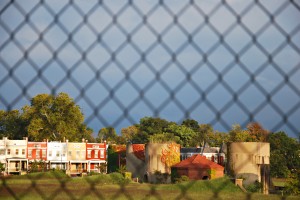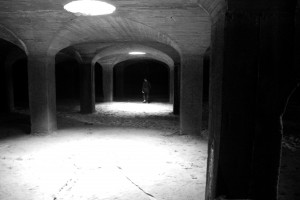LISTEN TO TONY NORMAN:
Audio clip: Adobe Flash Player (version 9 or above) is required to play this audio clip. Download the latest version here. You also need to have JavaScript enabled in your browser.
“You cannot separate the history of the District of Columbia from the history of the nation.” – Commissioner Tony Norman
Several decades before the Freedom Riders and sit-ins of the civil rights movement, McMillan Park was delivering devastating blows to segregation one cool gust of wind at a time. Before World War II, when air-conditioning was a rarity, it was common for families, both black and white, to escape D.C.’s summer heat by heading to McMillan Park to sleep out under the stars. Thus, thanks to its constant breeze, McMillan became one of first parks in the country to be integrated.
During World War II, the historic 25-acre park was fenced off and closed to the public for fear that the water purification system it sits atop would be tampered with. Despite promises to reopen the park after the war, the fences remain to this day.
There’s a bitter irony in cordoning off a park designed by Frederick Law Olmsted Jr. and the Olmsted Firm, which also did the landscaping for the U.S. Capitol, New York City’s Central Park, among many other projects throughout the U.S.
Like his father, Olmsted Jr. devoted his life to expanding public access to great parks. He succinctly described their work: “To conserve the scenery and the natural and historic objects and the wild life therein and to provide for the enjoyment of the same in such manner and by such means as will leave them unimpaired for the enjoyment of future generations.”
The fencing off of McMillan, which Pres. William Howard Taft declared a national park in 1911, becomes even more problematic when taking into account its majestic views. Looking directly south, one can see the U.S. Capitol. Turning clockwise, the site offers views of the Washington Monument, Howard University’s Founders Library Tower, National Cathedral, the Old Soldiers Home tower and the Basilica at Catholic University.
The sights underground are also breathtaking. Just beneath McMillan Park are twenty-four one-acre cells, which make up the slow sand filtration plant. Completed in 1905, the McMillan plant treated water without the use of chemicals.
Here’s how it worked: Each cell’s floor was covered with two-to-three feet of sand. Untreated water was pumped into a cell, on top of the sand. As the water percolated through the sand, impurities were removed, in much the same way a coffee filter operates. Beneath the sand was a catchment system which collected the water and brought it to an underground aquifer, where it was then distributed throughout the city, including to the White House and U.S. Capitol.
Originally, the sand in each cell had to be removed and cleaned approximately every twenty days. After being washed, the sand was dried in the twenty or so concrete silos that adorn the site. The sand was then returned to a cell and the cycle started over again. This labor intensive process required as many as 200 workers at one time.
In the early-to-mid 1980s, the McMillan Sand Filtration Plant was closed when a new plant opened across the street. With a fraction of the labor force, the new plant chemically treats D.C.’s water. While the savings are significant, the health impact from the chemical treatment is unknown.
District residents hardly ever get a chance to experience the McMillan site. “We do about one or two tours a year,” said Tony Norman, an Advisory Neighborhood Commissioner and activist with the McMillan Park Committee. “The city gives us a hassle in showing it because once people come on the site they’re very excited… [They ask], ‘Why don’t we do something creative [with it]?’ The District of Columbia has an opportunity to do something very unique on this site.”
But Vision McMillan Partners, the company the District sole-sourced development of the site to, has other ideas. VMP, whose principal developer is EYA, is looking to turn the historic site into to two million square feet of luxury condos and the like. “The residents want to see something here,” Commissioner Norman said, “but nothing this large or this dense.”
It’s not clear why the District didn’t put this massive project up for competitive bidding. Nor is it clear why, at the same time the District is attempting to deliver this sweetheart deal to VMP, it’s paying them as a contractor. What’s more, the District has taken on an unprecedented role in assisting VMP with its zoning application.
In a phone conversation, Jose Sousa, director of communications for the Deputy Mayor for Planning and Economic Development, described the District’s partnership with VMP as “non-traditional.” In a follow up email, he wrote, “The District does not have a standard template for the role it plays in development projects. It can often take a variety of shapes and forms.”
“This is extremely unusual and unprecedented,” said Norman. “I can’t think of any other project [where] this has happened in the District of Columbia. It’s an attempt to try to keep this developer involved in the process and take the risk out of the development.”
“It is not a done deal,” said Norman, who sees this as a statehood issue. “Other states reserve large amounts of land for preservation and preserve their heritage and their culture. D.C., if it wants to really be a state, it has to act like a state. And this site is part of the history of Washington, D.C.”
Members of Congress should also take an interest in McMillan, said Norman. “[McMillan Park] was designated to go on the National Register of Historic Places… When you look at the history of developing Washington, D.C. as a national city, this site was a crucial aspect of the L’Enfant Plan… Congress needs to take an [interest] in [this] because this is part of our national heritage, as well as the heritage of the District of Columbia.”
The question at stake here is an old one: Who owns the commons? Should McMillan Park’s majestic views and proud history belong to the few or the many?
Directly below is Tony Norman’s July 29, 2010 presentation to the DC Environmental Network. At the time, Adrian Fenty was mayor and Neil Albert was city administrator.
(Yesterday, Eric Fidler of Greater Greater Washington posted an interesting piece on McMillan’s history.)
Related Links:
www.ourmcmillan.com
Related Stories:
Historic McMillan Park Threatened by Luxury Condos, 1/26/11
Historic McMillan Park Under Attack, 10/15/10


